Well, two months after it was released, I’m finally getting to write about the PC Engine Mini. How is it?
Worth it. So, SO worth it.
After the delays and confusion over the US launch of the TurboGrafx-16 Mini, I did what just about everyone else did, and just ordered one from Japan. And since Amazon Japan no longer had the TG16 version when I decided to order, I went ahead and got the PC Engine Mini instead.

The PC Engine version is my favorite design of the three, anyway; I’ve never been a huge fan of the “elongated” design of the TurboGrafx console, and I already have an actual CoreGrafx (the CoreGrafx Mini is the European version of the three Minis, despite its never having been released in Europe in the first place), so the original PCE design was the winner for me.
The box is a replica of the original PC Engine packaging, except for the back, which shows the included games.



The package comes with the console, one controller, a manual, USB AC adapter, USB micro cable, and HDMI cable. Like the Sega Genesis Mini, the controllers are USB, and the only connections on the back of the console are the HDMI out and DC in.
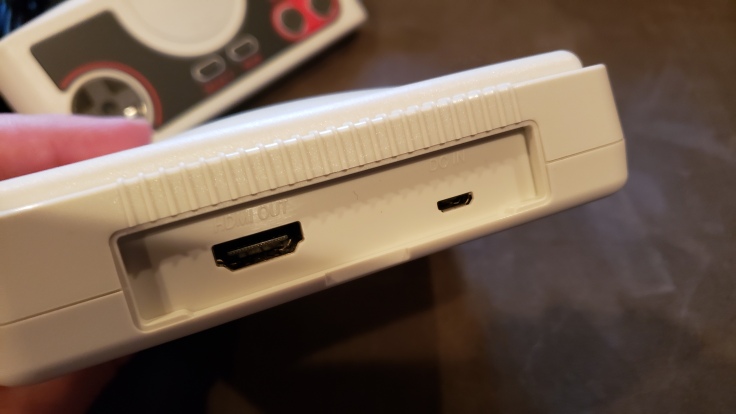
The one controller that’s included is an original-style, non-turbo-equipped pad. I’ve seen lots of users ordering the available turbo-equipped version after getting their Mini; I must admit, I’m thinking about it too.

Like the other mini consoles on the market, the attention to detail is spot-on. I love the fact that even though you can’t put a HuCard into the console, the little card lock still slides out when you switch the power on.

The actual PC Engine and Core Grafx models are already very compact, so making this a “mini” is a bit funny because it’s really not much smaller than the original!

It’s also similar in size to the Genesis/Mega Drive Mini. If you want to be a hair-splitting nerd about it, that means the PCE Mini is not really “to scale” with the Gen/MD Mini; if it was, the PCE Mini would have to be smaller still. But that’s not really necessary or expected so, ya know, don’t worry about it, nerd. They actually look quite lovely together, these two old 16-bit rivals:
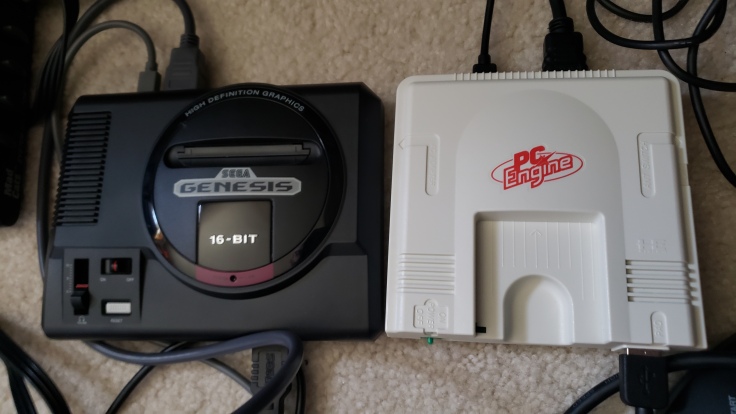
Okay, I’m done fetishizing the hardware (it’s so fun to do though). Let’s plug ‘er in!
Powering on for the first time, you are presented with your choice of language. Even in other languages, the game menus are the same (in contrast with the Genesis Mini, which changes the whole presentation between Genesis/Mega Drive depending on the chosen language).

The menu is a wonderful pastiche of PCE imagery, with the original game packaging shown, PCE console motifs everywhere, little anthropomorphic PCE dudes running around the screen, and fully animated sequences of HuCards being inserted into the cartridge slot and the CD-ROM drive spinning (complete with sound effects!).

The titles are even presented with their original colored spine format designations of HuCard, CD-ROM, SuperCD-ROM2, or Arcade Card. When switching consoles between PC Engine and TurboGrafx-16, a visual simulation of the TV turning off and back on again transitions into a completely different menu appropriate to the region.

The PC Engine menu can also be switched from a PCE theme to a CoreGrafx theme in the settings. Likewise, a variety of backgrounds and screen modes for the games are available so you can twiddle with plenty of options. There’s even a PC Engine GT/TurboExpress mode!
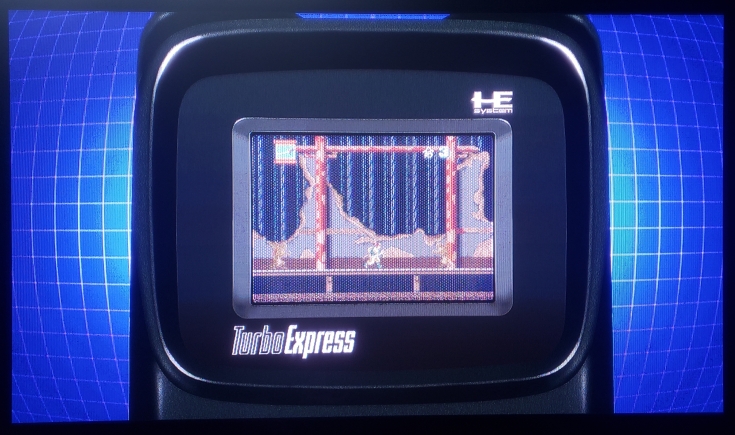
You can tell that there’s really a ton of love poured into this presentation — which makes sense once you realize that M2 are responsible for it. Seriously, they are the high priests of retro gaming spirit.
Enough about the menus and the glossy presentation, let’s play some games!
The game selection is pretty amazing, and that’s what sold me on this unit. Collectors’ market prices for original copies of many of the games here will run you well past the $100 price tag of the PC Engine Mini itself (Sapphire being the standout, with legit copies reaching 4 digits and even unlicensed reproductions approaching 100 bucks), making it an absolute bargain. Because of that, so many of these games are titles that I never obtained due to their cost or scarcity, but have always wanted to play. Spriggan 1 & 2, Star Parodier, Soldier Blade, Air Zonk (the HuCard version), and so many more legendary games that I didn’t have in my PCE and Turbo collection are finally mine to play.
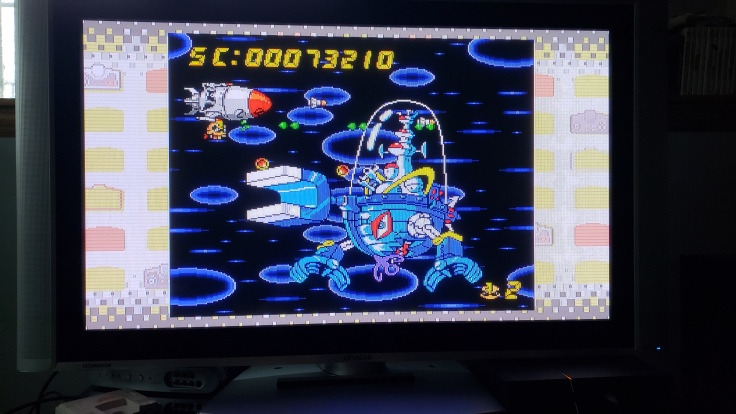
In fact, some games that I had sold off years ago are included, so I’m super stoked to have Galaga ’88 and Cadash back!
Even though the industrial designs are different, the only difference software-wise between the PCE Mini and TG16 Mini is that the TG16 replaces Tokimeki Memorial with Salamander. Otherwise, all the games, versions, and hidden Easter eggs are identical. While it’s true I’d rather have Salamander than TokiMemo, this thing is absolutely STUFFED with killer shmups, so Salamander is hardly missed.

To that point, it’s no stretch whatsoever to say that the PCE Mini is slanted heavily toward shootemups — not that I would ever complain about that, as the PC Engine is known for hosting some of the greatest shmups of all time. There are some great sidescrolling platformers too, though (Dracula X, Bonk, New Adventure Island, Splatterhouse, and Ninja Spirit being the standouts), a few strategy games like Military Madness, a couple racers including Victory Road and MotoRoader, and some standout RPGs/ARPGs like Ys I&II, Tengai Makyou II, and Neutopia I & II.

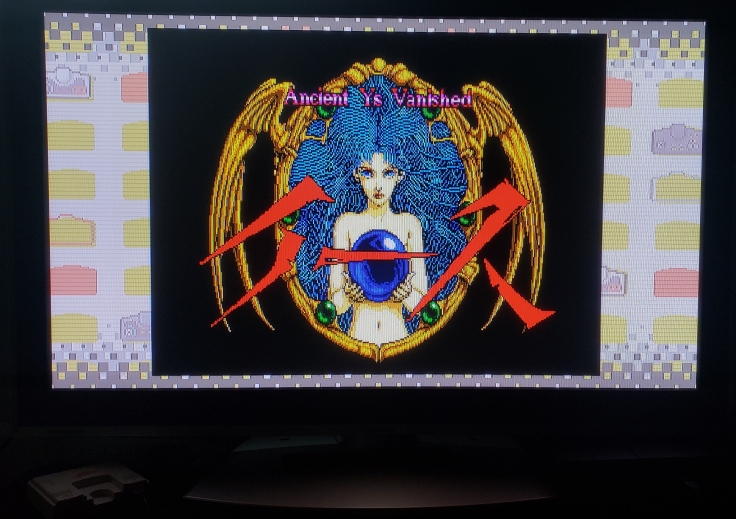
A few genre stragglers are also available, like the boardgame Super Momotaru Densetsu II, and the classic graphic adventure Snatcher (which, sadly, was not translated for the TG16 edition — chalk up a failed prediction on my part).
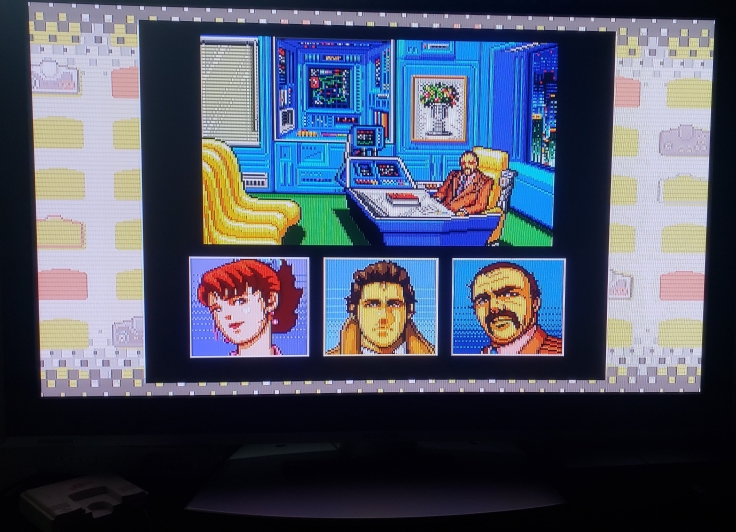
I think it’s awesome that so many CD-based titles were included in this collection, something the Genesis/Mega Drive Mini really could have benefited from.
Everything seems to run perfectly and smoothly; it all looks and sounds great to me, anyway. I haven’t felt the need to compare it back-to-back with original hardware, the way I did with the Neo-Geo Mini. I’ve heard complaints of input lag, but I’m actually not noticing it myself.
I also did my usual trick that I like to do with all of these HDMI retro consoles, and ran it through an HDMI-AV converter to a CRT. Other than the menu screen being “pinched” into 4:3, and some edges being a bit cut off, running the games at full-screen mode looks excellent on a tube!

One thing I feel the need to mention is that, as you know, the PCE Mini and its variations were released by Konami. So one obvious omission from the whole experience you may notice is the lack of the NEC logo anywhere on the hardware (the original had the NEC logo embossed on the upper right of the console and printed on the control pads).
Konami owns Hudson’s IP and hasn’t done much with it over the years. In fact, we all know that Konami’s reputation has pretty much gone downhill in recent years, and they haven’t even made many games out of their own classic IPs lately. However, as I mentioned, there is definitely a lot of reverence for the material here — and while that’s probably mostly due to the involvement of M2 (who also worked on the Mega Drive Mini), overall I have to hand it to Konami, as this product in and of itself is a step in the right direction toward pleasing longtime fans again.
While I love the other Mini consoles that I’ve gotten, I think the PC Engine Mini is probably my favorite, due to the sheer amount of legendary titles it makes available to gamers at a very reasonable price for what you get. With the TG16 Mini appearing in the US on May 22, I hope more gamers who have never experienced its magic finally get to learn what they’ve been missing!
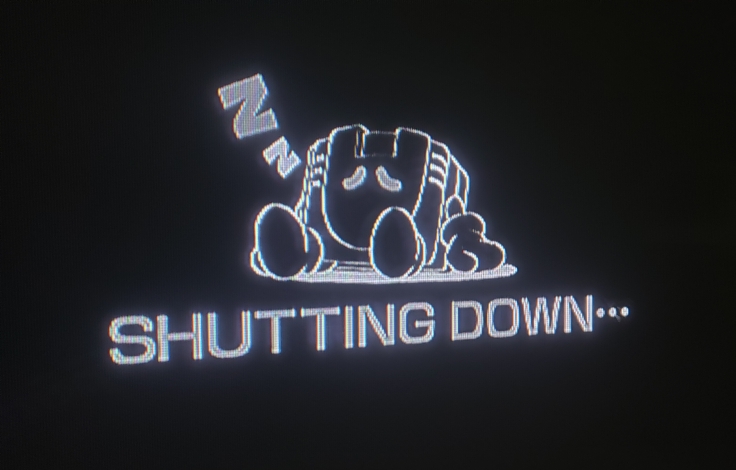


Leave a comment